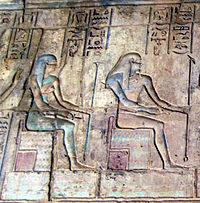This is an old revision of this page, as edited by Perceval (talk | contribs) at 03:17, 30 September 2016 (add popular culture header to differentiate modern content). The present address (URL) is a permanent link to this revision, which may differ significantly from the current revision.
Revision as of 03:17, 30 September 2016 by Perceval (talk | contribs) (add popular culture header to differentiate modern content)(diff) ← Previous revision | Latest revision (diff) | Newer revision → (diff)| A request that this article title be changed to Kek (mythology) is under discussion. Please do not move this article until the discussion is closed. |
| Kuk in hieroglyphs | ||||||
|---|---|---|---|---|---|---|
Kuk Darkness | ||||||
Kauket | ||||||
 | ||||||
Kuk (also spelled as Kek or Keku) is the deification of the primordial concept of darkness in ancient Egyptian religion. In the Ogdoad cosmogony, his name meant darkness. As a concept, Kuk was viewed as androgynous, his female form being known as Kauket (also spelled as Keket), which is simply the female form of the word Kuk.
Like all four dualistic concepts in the Ogdoad, Kuk's male form was depicted as a frog, or as a frog-headed man, and the female form as a snake, or a snake-headed woman. As a symbol of darkness, Kuk also represented obscurity and the unknown, and thus chaos. Also, Kuk was seen as that which occurred before light, thus was known as the bringer-in of light. The other members of the Ogdoad are Nu and Naunet, Amun and Amaunet, Huh and Hauhet.
In popular culture
Kek worship has become associated with 4chan and alt-right politics.
References
- Budge, Ernest. "The Gods of the Egyptians: Or, Studies in Egyptian Mythology, Volume 2". Retrieved 2016-07-22.
- Steindorff, Georg. "The Religion of the Ancient Egyptians". Retrieved 2016-07-22.
- Seawright, Caroline. "Kek and Kauket, Deities of Darkness, Obscurity and Night". Retrieved 2008-08-22.
He was the god of the darkness of chaos
- "Naked Nigel, the God Kek and modern politics".
This Ancient Egyptian religion article is a stub. You can help Misplaced Pages by expanding it. |
